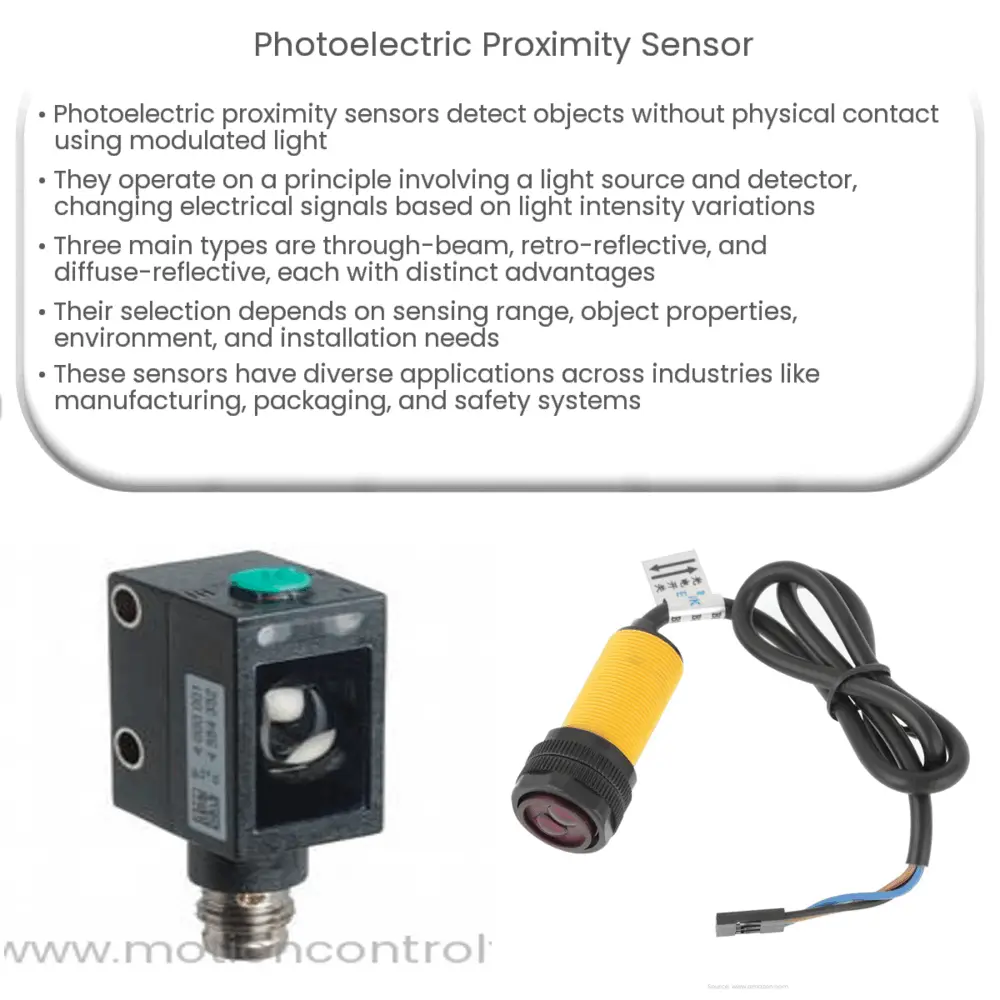A photoelectric proximity sensor detects objects without contact, using modulated light, with applications in manufacturing, safety, and automation.

Understanding Photoelectric Proximity Sensors: An Essential Guide
Introduction
Proximity sensors have been a vital component in various industries for many years. They are designed to detect the presence or absence of an object without physically touching it. Among the different types of proximity sensors, photoelectric sensors stand out as an efficient and reliable choice for diverse applications. This article will provide a comprehensive understanding of photoelectric proximity sensors, their working principles, types, and common applications.
Working Principle of Photoelectric Proximity Sensors
A photoelectric proximity sensor operates on the principle of modulated light. It consists of a light-emitting diode (LED) or laser diode as the light source and a photodiode or phototransistor as the light detector. The light source emits a beam of light, which is then reflected or interrupted by the target object. The light detector senses the change in light intensity and generates an electrical signal to indicate the presence or absence of the object.
These sensors are highly sensitive to changes in light intensity, enabling them to detect even small variations. They can also operate at long distances and are immune to electromagnetic interference, making them suitable for various applications.
Types of Photoelectric Proximity Sensors
There are three primary types of photoelectric proximity sensors: through-beam, retro-reflective, and diffuse-reflective. Each type has its unique advantages and applications.
1. Through-Beam Sensors
Through-beam sensors have a separate transmitter and receiver unit. The transmitter emits a beam of light that travels directly to the receiver. When an object interrupts the light beam, the receiver detects the change in light intensity and generates an output signal. This type of sensor offers the longest sensing range and highest accuracy but may require more complex wiring and mounting arrangements.
2. Retro-Reflective Sensors
Retro-reflective sensors have a combined transmitter and receiver in a single unit. A separate reflector is placed opposite the sensor. The light beam is emitted by the transmitter and reflected back by the reflector to the receiver. When an object interrupts the light beam, the receiver detects the change in light intensity and generates an output signal. This type of sensor has a moderate sensing range and is easier to install than through-beam sensors.
3. Diffuse-Reflective Sensors
Diffuse-reflective sensors also have a combined transmitter and receiver in a single unit. However, instead of using a reflector, these sensors rely on the target object to reflect the light back to the receiver. When the object is within the sensing range, the light is reflected and detected by the receiver, generating an output signal. This type of sensor has the shortest sensing range and is affected by the object’s color and surface characteristics but is the easiest to install and maintain.
Selection Criteria for Photoelectric Proximity Sensors
Choosing the appropriate photoelectric proximity sensor depends on several factors, such as sensing range, target object properties, environmental conditions, and installation requirements. To select the best sensor for a specific application, consider the following criteria:
- Sensing Range: Determine the required sensing distance between the sensor and the target object. Through-beam sensors offer the longest range, while diffuse-reflective sensors have the shortest range.
- Object Properties: Consider the object’s size, shape, color, and surface properties, as they can affect the sensor’s performance. Diffuse-reflective sensors are more sensitive to variations in object properties, while through-beam and retro-reflective sensors are less affected.
- Environmental Conditions: Evaluate the operating environment, including temperature, humidity, dust, and dirt, as these factors can impact the sensor’s performance and lifespan. Choose a sensor with appropriate ingress protection (IP) rating and material to withstand the environmental conditions.
- Installation and Maintenance: Consider the ease of installation, wiring, and maintenance. Diffuse-reflective sensors are generally the easiest to install and maintain, while through-beam sensors may require more complex mounting and wiring arrangements.
Common Applications of Photoelectric Proximity Sensors
Photoelectric proximity sensors are widely used across various industries due to their versatility, reliability, and efficiency. Some common applications include:
- Manufacturing and Automation: Detecting the presence or absence of products on conveyor belts, counting items, and verifying the position of robot arms or machine components.
- Packaging: Monitoring the filling level of containers, detecting the presence of caps, labels, or seals, and ensuring proper alignment during the packaging process.
- Material Handling: Identifying the position of items for sorting, controlling the height of lifting equipment, and preventing collisions between moving parts.
- Safety Systems: Providing safety barriers around hazardous areas, detecting the presence of people or objects in restricted zones, and monitoring the position of safety doors or gates.
- Agriculture: Monitoring the level of feed in silos, detecting the presence of animals in pens, and automating irrigation systems based on plant growth.
Conclusion
Photoelectric proximity sensors are an invaluable tool in various industries due to their ability to detect objects without physical contact, providing reliable and efficient solutions for countless applications. By understanding the working principles, types, selection criteria, and common uses, you can effectively choose and implement the most suitable photoelectric proximity sensor for your specific needs.

